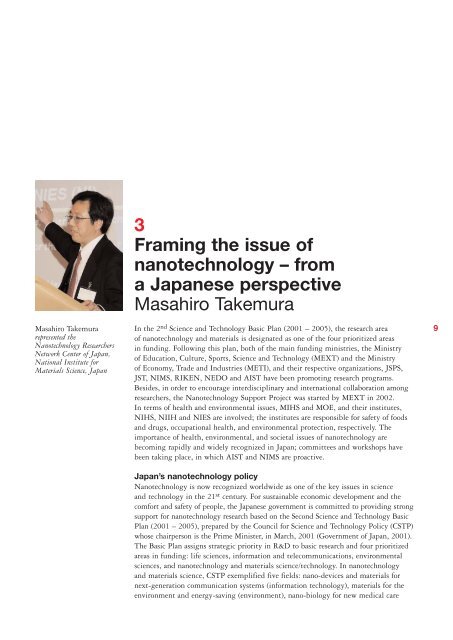Small size - large impact - Nanowerk
Small size - large impact - Nanowerk
Small size - large impact - Nanowerk
Create successful ePaper yourself
Turn your PDF publications into a flip-book with our unique Google optimized e-Paper software.
Masahiro Takemura<br />
represented the<br />
Nanotechnology Researchers<br />
Network Center of Japan,<br />
National Institute for<br />
Materials Science, Japan<br />
3<br />
Framing the issue of<br />
nanotechnology – from<br />
a Japanese perspective<br />
Masahiro Takemura<br />
In the 2 nd Science and Technology Basic Plan (2001 – 2005), the research area<br />
of nanotechnology and materials is designated as one of the four prioritized areas<br />
in funding. Following this plan, both of the main funding ministries, the Ministry<br />
of Education, Culture, Sports, Science and Technology (MEXT) and the Ministry<br />
of Economy, Trade and Industries (METI), and their respective organizations, JSPS,<br />
JST, NIMS, RIKEN, NEDO and AIST have been promoting research programs.<br />
Besides, in order to encourage interdisciplinary and international collaboration among<br />
researchers, the Nanotechnology Support Project was started by MEXT in 2002.<br />
In terms of health and environmental issues, MIHS and MOE, and their institutes,<br />
NIHS, NIIH and NIES are involved; the institutes are responsible for safety of foods<br />
and drugs, occupational health, and environmental protection, respectively. The<br />
importance of health, environmental, and societal issues of nanotechnology are<br />
becoming rapidly and widely recognized in Japan; committees and workshops have<br />
been taking place, in which AIST and NIMS are proactive.<br />
Japan’s nanotechnology policy<br />
Nanotechnology is now recognized worldwide as one of the key issues in science<br />
and technology in the 21 st century. For sustainable economic development and the<br />
comfort and safety of people, the Japanese government is committed to providing strong<br />
support for nanotechnology research based on the Second Science and Technology Basic<br />
Plan (2001 – 2005), prepared by the Council for Science and Technology Policy (CSTP)<br />
whose chairperson is the Prime Minister, in March, 2001 (Government of Japan, 2001).<br />
The Basic Plan assigns strategic priority in R&D to basic research and four prioritized<br />
areas in funding: life sciences, information and telecommunications, environmental<br />
sciences, and nanotechnology and materials science/technology. In nanotechnology<br />
and materials science, CSTP exemplified five fields: nano-devices and materials for<br />
next-generation communication systems (information technology), materials for the<br />
environment and energy-saving (environment), nano-biology for new medical care<br />
9
















